When entering a new market, the right sized salesforce will make or break whether the go-to-market strategy is effectively executed.
Hiring too many reps drains resources and limits the success of salespeople by over saturating the market. Not enough ‘feet-on-the-street’ means that a company will lag compared to its competitors, failing to grow during its pivotal first year.
Because of the challenge of estimating the right size of a sales team in a new market, many executives follow their instincts rather than digging into the facts to optimize market coverage and sales resources. This is a common mistake that can cause companies to miss between 2-15 percent of profitable revenue growth.
But there are effective ways that both mitigate risk and maximize revenue.
This article identifies:
- The key methods for discerning the number of salespeople to deploy into a new market or territory
- How these techniques will empower a leadership team to optimize their teams for long-term profit and reduce the opportunity costs of bad sales resource optimization.
Understand the Stage of the Business to Mitigate Risk
First, we encourage growth companies to ensure that they have established a concrete sales strategy before they think about sales force sizing. In particular, a company needs proof of a market opportunity, a detailed sales strategy, and the resources to hire salespeople who have proven they can excel in the company’s unique selling environment(s).
This approach mitigate the risk that resources and time are wasted on new salespeople before they’re ready for a sales team. For example, if an organization regularly changes the goals of the sales organization or hasn’t identified a target market and ideal customer base for each offering, the sales force won’t be able to close the right prospects — thus draining resources without contributing to the bottom line.
Although it’s vital that business leaders identify the ideal size of a sales force, they also need to source candidates with the right skills, experience, and sales DNA to fill the roles. Sales force competency gaps are detrimental to the ability of a company to successfully enter new markets, draining revenue and potentially damaging brand reputation.
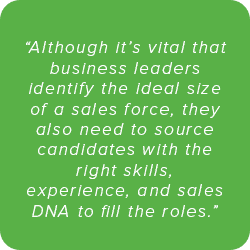
Salespeople need to adapt to multiple stops and starts as well as an extra level of rejection and resistance from leads. Not all salespeople, even the great ones, have the predisposition to be successful in a this kind of an environment. Given that, leaders of growth-stage companies need to create selection criteria to matches this unique selling environment. At Peak Sales, we look at candidates for growth-stage companies with the following sales DNA: ambition, optimism, flexibility, a comfort with uncertainty, perseverance, confidence, and an overriding sense of urgency.
Even for successful start-ups, it can be challenging to entice high-performing salespeople without a record of achievement or reputation within the industry; above-average compensation and the ability to have a material impact on the company as it grows can help usher in new recruits. Although these top performers require upfront investment, they’re less expensive than the alternative: mediocre salespeople.
Before building a new sales force, executives need to solidify their corporate and go-to-market strategies, assess their ability to pay top-performers, and estimate the expected length of the sales cycle. The longer the cycle, the longer it will be until an organization sees the returns on their investment in new headcount.
Match Territory Penetration to Sizing Needs
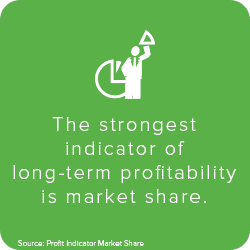
Unfortunately, some business leaders begin with a smaller sales force because they want to minimize headcount costs. They intend to hire more salespeople when costs equal profit. This “wait and see” approach can jeopardize market share, leading to compromised short and long-term profitability.
In fact, research from global consulting firm ZS Associate found that an understaffed sales team limits short-term revenue. Their team studied 11 health-care start-ups and found that the average sales force size was 46 percent smaller than it should be for optimal performance. Of that group, the start-up that outperformed their competitors in the short-term had the largest sales force.
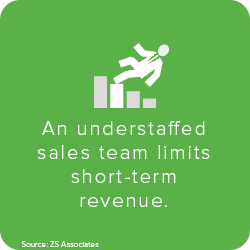
As cofounder of ZS Associates Adris A. Zoltners and writer Sally E. Lorimer summarize in Harvard Business Review, “The moment signs of success emerge, businesses should increase the size of their sales forces quickly and aggressively. Otherwise, they will forfeit sales and profits—and, perhaps, even their futures.”
Business leaders, therefore, need to find a balance between preparing a solvent sales strategy before hiring salespeople to execute that strategy.
Assess the Selling Capacity
Correctly sizing a sales team in a new market also depends on an analysis of the customers. That means leaders need to understand and segment customers to create a robust profile of each territory. From there, an organization can estimate how much selling time each segment requires. The collective, aggregated time from each segment gives leaders a clearer sense of the resources needed to support the customer base.
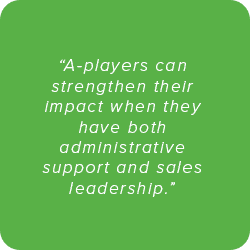
Just as executives consider selling capacity for reps, they need to make sure to add the infrastructure necessary to support and enhance selling activities. This can mean adding sales managers, inside sales reps, and administrative support personnel to the headcount. Even A-players can strengthen their impact when they have both administrative support and sales leadership. If you choose to hire sales reps before hiring a manager, consider screening for candidates who are player-coaches: They possesses the experience and time to hone strategy, forecast sales, hold reps accountability, and support a healthy culture.
Building out a sales force means accounting for the structure and support required to achieve quotas.
Use a Sizing Tool or Technique
By considering the life-stage of the business and assessing both the role of territory penetration and selling capacity, leaders gain a general sense of the ideal sales force size. They can bring extra depth and accuracy to the process by implementing a scientific technique that balances common-sense approaches to these decisions.
Not only do statistical methods strengthen confidence in sales force sizing, they serve as definitive facts for leaders who need to advocate for sales resources within the organization.
Although data is not perfect, these two approaches help mitigate risk by pinpointing the optimal sales force size:
Return on Sales Optimization
Return on sales optimization (ROS) is widely practiced in sectors with large, established sales forces, but it’s just as relevant to growth organizations trying to break into new markets. This calculation takes into account both cost and revenue, maximizing profit on sales investments while limiting risk. When implemented correctly, it widens the operating profit margin.
As Business Executive summarizes, optimizing ROS depends on several pieces of data: the segment and product profitability, the sales response function, and the costs for sales employees.
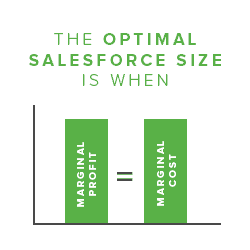
Efficient Frontier Benchmarking
This “top down” approach is a tool that leaders can use to both target the most profitable sales force size and improve operational efficiency. Like ROI optimization, efficient frontier benchmarking (EFB) identifies the sales force size with the greatest possible return at a limited risk. However, unlike other methods, this calculation accounts for the differences in market potential and teams across regions, calculating the “efficiency frontier” among a company’s distinct sales units.
To accurately predict EFB, leaders need estimated data on sales revenue, sales costs, and sales activities in ten sales districts, as well as some general insights into competitors’ performance.
Dan Horsky and Paul Nelson of University of Rochester also details the formula for EFB in full, highlighting exactly how executives can use it to make a clear assessment of a sales force size. Their method works with each district, enabling leaders to identify the optimal sales size both on the local and national level. The formula specifically accounts for the changes in salaries, market potential, and expected performance based on geographical area:
SPEOP = The optimized number of salespeople in the district
g = Gross margin in the district
y = Number of salespeople
c= Fixed cost of a salesperson in the district
POTEN= Sales potential
The optimized sales force on the national level is the sum of the number of salespeople in each district. If companies have a limit to the number of salespeople they can hire nationally, EFB also gives leaders a tool to assess which markets would most benefit from those extra reps. In short, EFB is extremely precise and useful when executives input accurate data.
In conclusion…
These techniques and tips for sales force sizing in a new market ensure that business leaders pursue the right approach when executing their go-to-market strategy. Each method and tool moves beyond gut instincts to build on proven headcount sizing approaches that support long-term sales and profit growth.
relpost-thumb-wrapper
close relpost-thumb-wrapper
Eliot Burdett
Eliot received his B. Comm. from Carleton University and has been honored as a Top 40 Under 40 Award winner.
He co-authored Sales Recruiting 2.0, How to Find Top Performing Sales People, Fast and provides regular insights on sales team management and hiring on the Peak Sales Recruiting Blog.
Latest posts by Eliot Burdett (see all)
- 20 Of Our Favorite Books About Sales Management and Sales Leadership – October 20, 2023
- How To Make Progress On Your Sales Goal Without A Sales Leader – September 15, 2021
- Augment Your Recruiting Strategy During “The Great Resignation” – July 26, 2021






